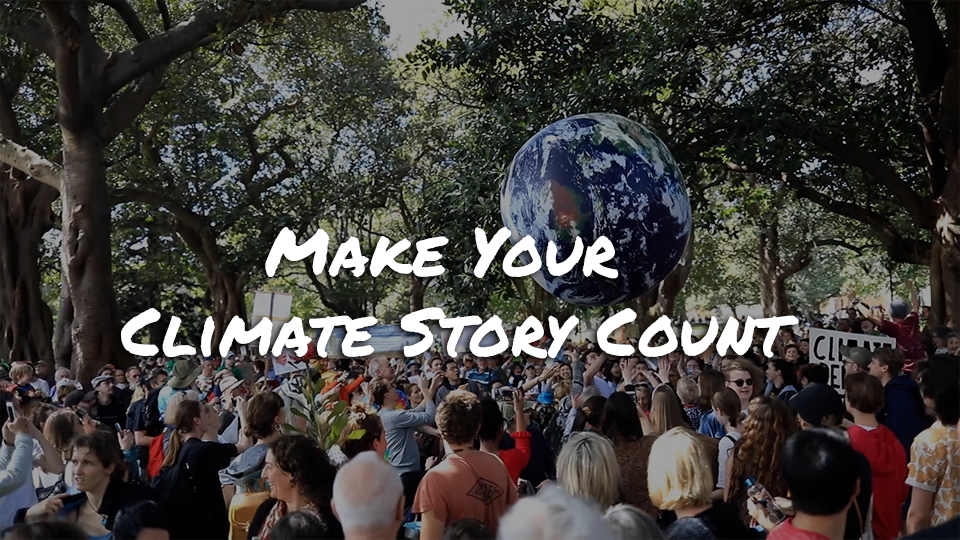Three ways to make your climate story count
We’ve seen the graphs, we know devastating stats and we’re all too aware of the data, yet too many are still dragging their feet in addressing climate change. While the numbers are important and give us the all-important ‘back-up’ for what we know to be true, numbers alone don’t paint the full picture. Rather, they can make us feel disconnected, despondent, and disengaged. So, what starts to grow the political and community will to take immediate action on arguably the most pressing issue of our time? Powerful stories of those on the frontlines, and the ability to share them.
Storytelling is critical to the success of climate action
Stories prompt action by humanising the real world effects of issues like climate change, putting human (or animal!) faces to the devastating impacts of bushfires, droughts, flash floods, and rising sea levels. It is the process of telling, hearing and sharing stories of people’s lived experiences on the frontlines that engages us emotionally and enables us to feel, connect and respond to issues – and each other – more deeply. As such, especially in this adaptive phase, storytelling must play a central role in the climate action movement to build resilience and inspire immediate action before it’s too late.
A powerful example of climate storytelling, by Greenpeace Australia
Here are three tips to help you elevate your climate storytelling and make sure your climate story counts before it’s too late…
1. Think of key ‘questions’ rather than key ‘messages’❓💬
This pearl of wisdom was shared with us by one of the wonderful participants at our COP26 Climate Storytellers session!
You would have probably heard your friendly neighbourhood communications, marketing or storytelling people (yes, that includes us) talking about nailing your ‘key messages’ – or the ‘things’ you want to say and that you want your audience to remember. But in climate storytelling, one very effective tactic is to shift from determining a set of key messages to identifying the key ‘questions’ you want to ask and letting that form the basis of your climate story.
Rather than prescribe what you want people to think or remember, you invite them to reflect on and consider key questions such as:
- ‘What does a world look like where the reefs are healthy, natural ecosystems are thriving and crops are bountiful and overflowing?’ instead of → addressing climate changes means more healthy reefs, ecosystems and food supplies.
- ‘Where do we go when there’s nothing left?’ instead of → there is only one planet.
- ‘Who is going to take action if you don’t?’ instead of → you must take action, now.
- ‘Whose voices are not in this room?’ instead of → people on the frontlines are not being heard.
So, what are the key questions you want to ask and what’s the most effective and memorable way to ask them?
2. Balance the head 🧠, heart 💓 and hands 🙏
The best stories strike the perfect balance between the ‘head’ (data, science, systems thinking and the more rational aspects), the ‘heart’ (the personal experience, moving beyond logic to speak to our core values) and the ‘hands’ (practical and tangible community driven action). Climate storytelling is no different.
By creating a potent mix of data to latch onto, personal experiences to connect and empathise with and providing clear, actionable pathways you can amplify your work fighting for a greener, cleaner future. Here’s a great example from our recent Climate Storytellers program in the lead up to COP26:
3. Meet people where they are 🤝
Engaging storytelling meets people where they are, so it’s important to consider the many different entry points that your audience might have into your story before putting pen to paper (or tape to rolling).
For example: is your way in through their connection to family or community? Is it through lifestyle or that their favourite places and foods will begin to disappear? Is it through injustice and equality? What about through technology and innovation? Find out what makes them tick and what moves them to action and your climate story will be infinitely more effective.
And remember: it’s not about being manipulative. It’s about doing your audience the honour of showing that you understand them and presenting issues in ways they can relate to and that makes issues meaningful to them. This approach also helps to overcome climate change’s reputation as a political hot potato, where discourse can be highly divisive and derisive. We need to find common ground before we can hope to tread forward.
Bonus tip: Show, don’t tell
This one goes for all storytelling, not only climate storytelling, but you’ve got to show your story, not just tell it. As the saying goes, if a picture is worth a thousand words then a moving picture (a.k.a a video) is worth a million. Given that climate change can sometimes feel intangible and theoretical, using photography, videos and visual imagery to bring your story to life helps to spread the message much further.
In response to seeing the story from the Alliance of the River Three (above), one of the participants at our COP26 Climate Storytellers session remarked:
“One thing that struck me about that visual storytelling was that it showed the environment, it showed the biodiversity, the butterflies, the ‘other than human’ life, so there was a focus that wasn’t just about the people. There was a real warmth, and passion expressed. I thought it was beautiful.”
We are passionate about supporting climate activists to make their stories count. If you are part of a local climate action group or organisation with an exciting new sustainability initiative:
-
Sign up to our FREE Climate Storytellers Online Course
-
Get in touch about a bespoke Climate Storytelling workshop
-
And be sure to join the Climate Storytellers Collective, in partnership with CLEAR Environmental.

